Kate Lawrence's Blog, page 2
February 21, 2015
No Mud, No Lotus
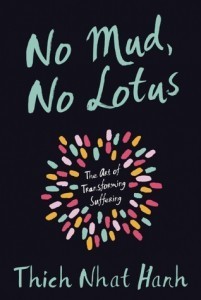 No Mud, No Lotus: The Art of Transforming Suffering, by Thich Nhat Hanh. Parallax Press, 2014.
No Mud, No Lotus: The Art of Transforming Suffering, by Thich Nhat Hanh. Parallax Press, 2014.
This short, easy to read guide offers practical suggestions, from a Buddhist perspective, on how to deal with the everyday suffering that arises for everyone. Nhat Hanh makes clear that it is impossible to avoid suffering, as that is part of living, but we can choose to keep it from overwhelming us. The book’s “Practices for Happiness” section includes breathing exercises, being present with strong emotions, practicing loving kindness toward ourselves and others, deep relaxation, mindfulness trainings and walking meditation.
To give an example of just one of those–being present with strong emotions–Nhat Hanh reminds readers that “an emotion is only an emotion, and you are much more than one emotion . . . An emotion is something that comes and stays for a while, and eventually goes away. If during the time of the emotion, you have that insight, that insight will save you.”
People caught up in stressful situations can find real support and encouragement here.
January 29, 2015
The Modern Savage
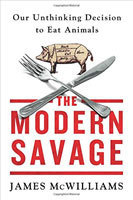 The Modern Savage: Our Unthinking Decision to Eat Animals, by James McWilliams. Thomas Dunne Books, 2015.
The Modern Savage: Our Unthinking Decision to Eat Animals, by James McWilliams. Thomas Dunne Books, 2015.
Once again James McWilliams proves that he is one of the most articulate thinkers and writers we have on the subject of how we treat animals used for food. Regarding so-called “humanely-raised” meat, he shows readers that chickens, pigs, and cows have emotional lives, suffer and do not want their lives cut short to provide food humans don’t need. It is not ethically acceptable to claim to care about them, give them a more natural life for awhile, and then kill them. And in case you want details on typical slaughter procedures, that’s in here too.
“Humanely-raised” animals allowed to live outdoors can be even more disease-prone than those in factory farms, picking up infections from the soil and contact with feces. McWilliams cites numerous blog posts from small farmers giving their animals a marginally better life, but dealing not only with frequent diseases arising from an outdoor environment, but losses to extreme weather and, in the case of chickens, to predators–often a grisly death for the chickens. These “humane” farmers also mutilate their animals–for example, castrating male pigs without anesthesia–and farmers who do their own slaughtering can be shockingly inept, causing greater suffering than if the animals had been taken to a commercial slaughterhouse.
Food labels can mislead consumers about what they are really buying. So-called “grass-fed” cattle are not entirely grass-fed; many must be fed hay to survive–hay that must be grown elsewhere. And here’s a surprise: grass-fed cattle are no less likely to be infected with deadly E.coli than those fed grain and confined on feedlots.
The outrages and inconsistencies go on and on. The only way to remove oneself from supporting cruel treatment of “food” animals is not to eat them. Period.
January 5, 2015
5280 Magazine Misses the Meat of the Matter
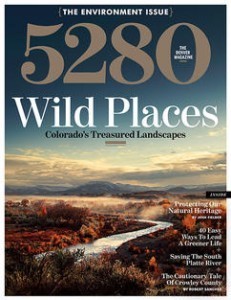 5280 The Denver Magazine recently featured an article on “Everyday Environmentalists,” presenting over 40 ways to live greener. Pointing out that Coloradans are not as environmentally virtuous as we may think we are, the article featured excellent advice on such topics as home insulation, composting, gardening, biking–the usual and more. Some items were very detailed, such as the advice to buy a live Christmas tree instead of an artificial one, and then plant it outside. Readers who hike popular mountain trails were encouraged to go during the week so as to increase the likelihood that they will stay on the trail and minimize trail deterioration. Yes, yes, yes, I’m saying to myself as I read, but when do we get to the huge environmental impact of meat consumption?
5280 The Denver Magazine recently featured an article on “Everyday Environmentalists,” presenting over 40 ways to live greener. Pointing out that Coloradans are not as environmentally virtuous as we may think we are, the article featured excellent advice on such topics as home insulation, composting, gardening, biking–the usual and more. Some items were very detailed, such as the advice to buy a live Christmas tree instead of an artificial one, and then plant it outside. Readers who hike popular mountain trails were encouraged to go during the week so as to increase the likelihood that they will stay on the trail and minimize trail deterioration. Yes, yes, yes, I’m saying to myself as I read, but when do we get to the huge environmental impact of meat consumption?
Livestock agriculture is responsible for over half of greenhouse gas emissions–contrary to the article’s assertion that electricity is the largest source–and uses far more water than anything else humans do. You could save more water by not eating a pound of beef than you could save by not showering for a year. Not to mention the tons of manure livestock produce: have the 5280 staff ever driven past the feedlots in northeastern Colorado? According to “A Life Connected,” livestock agriculture nationwide creates enough manure to rebuild the entire Denver skyline out of poop every 24 hours.
In the 5280 article–a full eight pages of (mostly) small-print–meat gets exactly one sentence, about grass-fed beef. One sentence! Easily the most important thing Coloradans and everybody else can do to clean up the environment is to reduce–or ideally eliminate–the consumption of meat, eggs, and dairy products. Every meatless meal makes a measurable difference. Furthermore, making these dietary changes doesn’t require some new product or major political or corporate change. Individuals can do it one choice at a time in their own homes or at restaurants with nothing more complex than their forks.
While I don’t fault anyone for wanting to replace their Windex with vinegar and cornstarch, or renting a baler for their recyclables, let’s get real: livestock agriculture dwarfs every other human activity in terms of its destructive environmental impact. Changing our diet is far and away the “greenest” thing each of us can do.
December 24, 2014
Indelible
 Indelible: Denver’s Lasting Impressions of the Library. Denver Public Library. Tattered Cover Press, 2014.
Indelible: Denver’s Lasting Impressions of the Library. Denver Public Library. Tattered Cover Press, 2014.The Denver Public Library, to celebrate its 125th anniversary this year, asked the community to submit short essays to be considered for inclusion in a commemorative book. The topic to write about was what you love about the library. I submitted an essay about the many ways my life has been enriched by DPL, from my finding there the book that first put me on the path of vegan activism, which led to my meeting and marrying my husband of 25 years, to my being hired as a DPL librarian where I worked until retirement, to saving me thousands of dollars over the years on books and movies. My essay was among those selected and is included in the book. I have good company between these covers: well-known authors and scholars, people looking for a better life and using library resources to achieve it, children and teens whose awareness of the world expands beyond what they’d previously thought possible. Many of the stories people share bring a lump to the throat, and remind readers of the vital importance and lasting influence of our public libraries.
November 26, 2014
This Changes Everything–new book by Naomi Klein
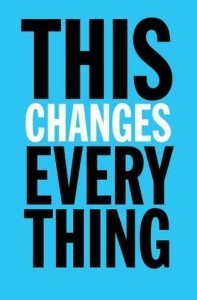 This Changes Everything: Capitalism vs. The Climate, by Naomi Klein. Simon & Schuster, 2014.
This Changes Everything: Capitalism vs. The Climate, by Naomi Klein. Simon & Schuster, 2014.
Despite a serious omission (see below), I recommend this highly. Watch the inspiring book trailer here. Klein is objective, compassionate, a solid reporter and researcher, and one of our best commentators on politics. Anyone wanting a current overview of what’s happening worldwide about climate change will find here a thorough investigation and explanation, along with a consistently upbeat view of how the frightening current situation could be turned around. Time is very short if we are to keep global warming below 2 degrees C., but people are coming to understand that our leaders are not leading; grassroots groups are rising up around the world to stop extractive projects (fracking, mining, pipelines). I learned a great deal, which would have taken me countless hours to research on my own, on such subjects as Indigenous rights movements and their importance, civil disobedience actions around the world, geoengineering proposals, and much more.
One critical factor was omitted entirely: the impact of livestock agriculture, which contributes more than half of all greenhouse gas emissions. (I hope Klein will watch the new documentary “Cowspiracy.”) If we are to stay below that 2 degree global temperature increase, we must actively encourage the reduction (ideally, elimination) of meat, dairy and egg consumption. Besides its general relevance, this topic would also fit into Klein’s concern, in her chapter on Regeneration, about species damaged by fossil fuel pollution whose young either cannot develop after conception or once born/hatched, cannot thrive. This large-scale loss of animal life is happening not only with wildlife but with, for example, chickens. There are not thousands or millions, but billions of newly hatched male chicks in the egg industry that are killed by being ground up alive. But even if we look only at wild animals, the livestock industry is responsible for the deaths of many millions of them by gobbling up land and water resources on which wild animals depend, by pesticide use on the vast fields used to grow livestock feed, and by outright trapping or poisoning of coyotes, wolves and other supposed predators of cattle and sheep.
The only position Klein took that surprised me was her statement that IVF and other assisted reproduction procedures should be covered by public health insurance. It seems to me that in the face of out-of-control overpopulation, we should be discouraging–not encouraging–reproduction.
Overall, though, Klein’s latest is an impressive achievement. I hope it is widely and carefully read, and that it will encourage the kind of climate activism we so desperately need.
November 12, 2014
New Movie: “The Theory of Everything”
 I had the chance to attend an advance screening of a new movie set to open this weekend. “The Theory of Everything” is the life story of physicist Dr. Stephen Hawking and his wife Jane. It is a tribute to Hawking’s determination to persevere despite being paralyzed (he had ALS), his wife’s courage in accepting and accommodating his handicaps, and an intimate look at the tender love between them. He had already received the diagnosis of his disease at the time they fell in love as college students, but she went ahead and married him anyway. The film explores how their feelings change over time.
I had the chance to attend an advance screening of a new movie set to open this weekend. “The Theory of Everything” is the life story of physicist Dr. Stephen Hawking and his wife Jane. It is a tribute to Hawking’s determination to persevere despite being paralyzed (he had ALS), his wife’s courage in accepting and accommodating his handicaps, and an intimate look at the tender love between them. He had already received the diagnosis of his disease at the time they fell in love as college students, but she went ahead and married him anyway. The film explores how their feelings change over time.
We need more stories of patience and love in the face of adversity. “Theory” is beautifully acted by Eddie Redmayne and Felicity Jones– watch the trailer here.
October 18, 2014
Waking Up
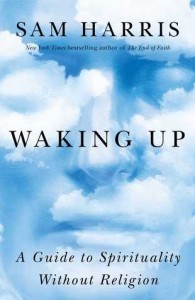 Waking Up: A Guide to Spirituality without Religion, by Sam Harris. Simon & Schuster, 2014.
Waking Up: A Guide to Spirituality without Religion, by Sam Harris. Simon & Schuster, 2014.
Harris covers highlights of his own inner journey and what we currently know about the nature of consciousness, concluding with comments on evaluating gurus, investigating NDEs, and drug use as a possible path toward enlightenment. Meditation practice can be helpful to everyone as a means of reducing the personal suffering brought about by constant distraction, and needn’t have any religious component. Harris’ dedication to exploring the self, his considerable experience attending meditation retreats–a total of two years, including some three-month periods–plus his background as a neuroscientist give the book an unusual and authentic flavor. Definitely worth pondering.
September 25, 2014
Of Activism and Autumn Aspen
This past week has seen not one but two climate change actions in Denver, both organized by 350.org. The first was to meet the train filled with people heading on to New York for the People’s Climate March September 21. We gathered in front of Union Station for speeches and singing, then went around to the back and watched the train come in at the platform. Several dozen climate activists got off and joined the rally, adding to the enthusiasm. I was able to hand out flyers and talk to some people about veganism. It was great to see so many others (about 250) who are as concerned as I am about climate change.
 Then Sunday, at the same time that the People’s Climate March was going on in NYC, a group gathered in Denver on the west steps of the capitol. Keith and I were pleasantly surprised to see more vegans there than we expected, several with additional signs, to amplify our presence. Each group represented there could have someone give a brief speech, so I took a turn standing front and center. I explained that over half of greenhouse gas emissions come from livestock agriculture, and urged the crowd to “make a difference every day with your fork.” The group applauded; overall, I felt more support for the vegan message here than I previously had among environmental activists. In fact, the lead speaker of the event commented, “You vegans are well organized.” After the speeches, the group marched in front of the capitol and down the 16th Street Mall downtown, chanting, waving signs and engaging passersby.
Then Sunday, at the same time that the People’s Climate March was going on in NYC, a group gathered in Denver on the west steps of the capitol. Keith and I were pleasantly surprised to see more vegans there than we expected, several with additional signs, to amplify our presence. Each group represented there could have someone give a brief speech, so I took a turn standing front and center. I explained that over half of greenhouse gas emissions come from livestock agriculture, and urged the crowd to “make a difference every day with your fork.” The group applauded; overall, I felt more support for the vegan message here than I previously had among environmental activists. In fact, the lead speaker of the event commented, “You vegans are well organized.” After the speeches, the group marched in front of the capitol and down the 16th Street Mall downtown, chanting, waving signs and engaging passersby.
Two days later, I was hiking in the high country when the fall color was at its peak at 10,000 ft. 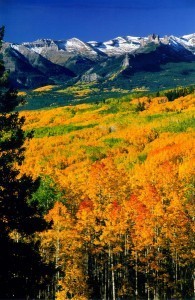 “Fall color” at that altitude means almost entirely aspen, as the other trees are all evergreens. But the aspens step up and really put on a show, weaving among the dark green evergreens in all imaginable shades of yellow, gold, and orange. To hike up to a high ridge and be able to look over an entire valley of such color, along with the intense blue of the sky and the purple of distant ranges, is breathtaking; view after view unfolded before me. I recalled an article I’d read a couple of weeks earlier in the Denver Post about tree cover in the Colorado Rockies. Entitled “Rocky Mountain Forests Are Dying,” it cited a Union of Concerned Scientists and Rocky Mountain Climate Organization report warning that the tree species that have covered these mountains for centuries are in grave danger as the climate warms. The report projected that only a fraction of our forests will still be here by 2060. Already the forests in some areas have been visibly decimated by bark beetles able to flourish during warmer winters.
“Fall color” at that altitude means almost entirely aspen, as the other trees are all evergreens. But the aspens step up and really put on a show, weaving among the dark green evergreens in all imaginable shades of yellow, gold, and orange. To hike up to a high ridge and be able to look over an entire valley of such color, along with the intense blue of the sky and the purple of distant ranges, is breathtaking; view after view unfolded before me. I recalled an article I’d read a couple of weeks earlier in the Denver Post about tree cover in the Colorado Rockies. Entitled “Rocky Mountain Forests Are Dying,” it cited a Union of Concerned Scientists and Rocky Mountain Climate Organization report warning that the tree species that have covered these mountains for centuries are in grave danger as the climate warms. The report projected that only a fraction of our forests will still be here by 2060. Already the forests in some areas have been visibly decimated by bark beetles able to flourish during warmer winters.
As I gazed out at the autumn splendor, I wondered: am I in one of the last generations to be able to see this? and felt a lump rise in my throat. Am I? Are we humans just going to let our planet die? I fervently hope that the huge numbers who turned out for the NYC People’s Climate March last Sunday are an indication that the public is becoming increasingly vocal about demanding change. We can only hope that governments around the world will begin to make a serious response to the leadership of the people.
August 18, 2014
Standing Up for Rabbits
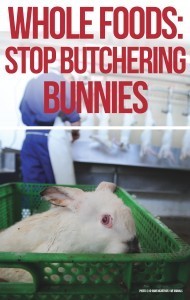 I was proud to take part in the Day of Action yesterday in Boulder to urge Whole Foods to stop selling rabbit meat. Rabbits are the third most popular companion animal; would Whole Foods start selling dog meat if some customers asked for it? I learned that, although Whole Foods does not permit cosmetic testing on rabbits for products sold in their Whole Body section, they slaughter the very same breed of rabbits for their meat department! “Pets are not food!” was heard across the country. Margo DeMello, president of the House Rabbit Society, has written a well-reasoned article on the issue. See these great photos taken at some of the 44 protest events nationwide at WF stores.
I was proud to take part in the Day of Action yesterday in Boulder to urge Whole Foods to stop selling rabbit meat. Rabbits are the third most popular companion animal; would Whole Foods start selling dog meat if some customers asked for it? I learned that, although Whole Foods does not permit cosmetic testing on rabbits for products sold in their Whole Body section, they slaughter the very same breed of rabbits for their meat department! “Pets are not food!” was heard across the country. Margo DeMello, president of the House Rabbit Society, has written a well-reasoned article on the issue. See these great photos taken at some of the 44 protest events nationwide at WF stores.
I was proud to take part in the Day of Action yesterday i...
 I was proud to take part in the Day of Action yesterday in Boulder to urge Whole Foods to stop selling rabbit meat. Rabbits are the third most popular companion animal; would Whole Foods start selling dog meat if some customers asked for it? I learned that, although Whole Foods does not permit cosmetic testing on rabbits for products sold in their Whole Body section, they slaughter the very same breed of rabbits for their meat department! “Pets are not food!” was heard across the country. Margo DeMello, president of the House Rabbit Society, has written a well-reasoned article on the issue. See these great photos taken at some of the 44 protest events nationwide at WF stores.
I was proud to take part in the Day of Action yesterday in Boulder to urge Whole Foods to stop selling rabbit meat. Rabbits are the third most popular companion animal; would Whole Foods start selling dog meat if some customers asked for it? I learned that, although Whole Foods does not permit cosmetic testing on rabbits for products sold in their Whole Body section, they slaughter the very same breed of rabbits for their meat department! “Pets are not food!” was heard across the country. Margo DeMello, president of the House Rabbit Society, has written a well-reasoned article on the issue. See these great photos taken at some of the 44 protest events nationwide at WF stores.



